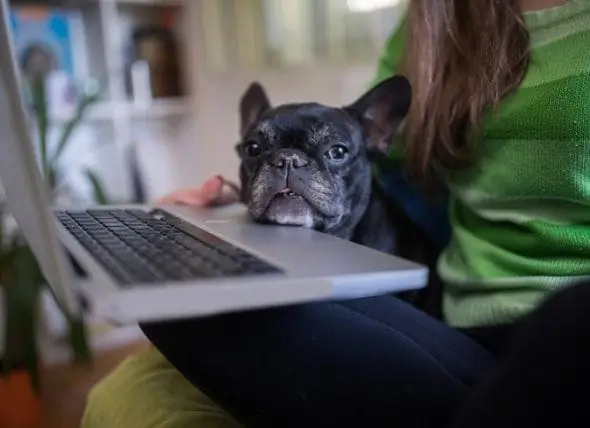
- Szerző Daisy Haig [email protected].
- Public 2023-12-17 03:09.
- Utoljára módosítva 2025-06-01 06:47.
Tehát minek is ez a kínos kakaateszt?
Elég stresszes, ha kedvence hátát műanyag rúd sérti, nem? Tehát mi értelme van?
Azt mondod: Ha a cél az, hogy háziállatom egészségesebbé és parazitamentesebbé váljon, akkor bízom az ítélőképességedben, de azt kell mondanom, hogy a széklet ellenőrzése egyfajta kegyetlen és szokatlan büntetés. Addig nem kapok ilyen megalázást, amíg férfi és negyvenéves vagyok, igaz? És a széklet nem olyan hasznos, igaz?
Mondom: Először is, nem kell, hogy háziállata engedjen a gazember rúdjának. Friss mintát általában könnyen meg lehet szerezni reggel (vagy délután) az éves látogatás előtt, vagy bármikor, amikor kedvence gyomor-bélrendszeri tüneteket szenved. Tényleg nem olyan kemény. És ha az időzítés nem teljesen megfelelő (a székletnek a legjobb eredmény elérése érdekében nem lehet egy óránál régebbi), akkor az állatorvosi kórház biztosan nem fogja megtagadni a jogot arra, hogy kényelmesen szuperfriss mintát vigyen be. Ígéret.
És igen, a székletvizsgálatok, bár viszonylag olcsóak és rutinszerűek, nélkülözhetetlenek. De amint ez a bejegyzés bebizonyítja, az is igaz, hogy nem minden székletvizsgálat veszi fel a parazitafertőzést a háziállatokban. Ezért lehet szükség éves és / vagy soros székletvizsgálatra.
Most a teszt elsődleges célja:
Az állatorvosok mindig keresik azokat a parazitákat, amelyek utat találhatnak kedvencei gyomor-bél traktusába. Persze, mi emberek is kaphatunk parazitákat, de modern életmódunk általában kevésbé kedvez a parazitafertőzésnek. (Mikor mentél utoljára szippantani az udvaron, ajkak a földig, csak azért, hogy belélegezz egy vagy két macskafélét?)
Igen, a háziállatok sok parazitát kapnak. Itt van egy minta a leggyakoribb gyomor-bél parazitákról, amelyeket itt látok [a parazita mennyországban, amely félig trópusi dél-floridai]:
Körömférgek kutyákban és macskákban.
Horogférgek háziállatoknál
Ostorférgek háziállatoknál
Giardia háziállatoknál

A máj petyhüdt háziállatoknál
A máj petyhüdt háziállatoknál
coccidia in pets
i’ll not go into the gory details on each but you can click on the links and check out the info for a better understanding of how these parasites can potentially affect your pets and even your human family.
sure, pet-popular parasites don’t often infect humans in the so-called, “developed” nations all of you reading this likely live in, but that doesn’t mean it doesn’t happen. roundworms and hookworms are still a factor in humans in the us, as is giardia, which will give you the nastiest case of diarrhea you can imagine short of amoebic dysentery.
since veterinarians are also on the front lines when it comes to public health, consider that fecal exams are not just necessary for healthy pets, they’re essential for healthy humans, too, more so if your family members are very young children, very old adults or otherwise immunocompromised (transplant patients, hiv-positive humans, chemo recipients, etc.).
how do we identify these critters in the fecal exam?
the short answer: with a microscope.
the long answer: we take a tiny sample of your pet’s stool (very fresh is always best). a few grams is enough (think an eighth of a teaspoon if that’s easier). then we put it through one of three processes.
1. the smear: we take about a half gram of stool and smear it onto a microscope slide to search for parasites (and bacteria) directly. many times we’ll see them swimming about. finding evidence of parasites in a simple smear is often indicative of severe infection.
2. the float: this method relies on mixing the stool with a special solution. it filters out the big pieces of stool in a tube or other cylindrical vessel and allows the eggs and other small critters to float up to the top, buoyed by the solution’s specific gravity. a microscope slide’s cover slip is typically used to recover the floaters. some parasites, however, aren’t amenable to flotation. eggs seem to do best through this method.
3. centrifugation: spinning the heck out of stool in a centrifuge when it’s mixed in a sugar solution picks up about 50% more parasite eggs and oocysts than through flotation. therefore, i like this method best for worm eggs, giardia, and coccidia--though i’d never go without a smear. problem is, most hospitals don’t yet use this method. it’s more expensive than others and research demonstrating it’s much greater efficacy is fairly recent.
so now you know the truth: not all fecal exams are created equal. not only does this test rely on careful selection of materials and methods, it also requires a trained eye. in our practice, for example, one of our techs detects parasites about 50% more often than the veterinarians and other techs/assistants. (that’s why we also do floats so that she can check them all at her convenience when she comes back from her day off.)
it’s also true that even a parasite-infected animal will often not come up positive on a fecal test. human error and equipment choice are factors, but so is the parasite itself. sometimes they do not make themselves known in the stool. worms sometimes aren’t shedding their eggs and subclinical (low-grade or smoldering) infections may not reveal much, either.
again, that’s why it’s important to perform this test as often as is reasonable. for all dogs and cats at least three times during the first few months of life. i want to see at least two negative tests in a row, a month apart, before i’ll feel comfortable that my patient is parasite-free.
for adults, once a year is great--that is, unless they show gastrointestinal illnesses. in this case, serial fecal tests make sense--or at least one every time the symptoms recur until a definitive diagnosis is made (whether it’s parasites or something else).
ultimately, fecal tests are a critical component of our veterinary hat of tricks. doing without may seem like the economically wisest thing in the absence of gastrointestinal symptoms, but consider: parasites can wear pets down in ways you might not expect. and it’s never wrong to be too safe in the presence of diseases that may also affect your family. ‘nuff said.
Ajánlott:
Hogyan Tervezzük Meg Kedvence Gondozását, Ha Megkapja A COVID-19-et

Dr. Katy Nelson állatorvos tanácsai a háziállat megtervezéséhez, ha COVID-19-et kap. Tudja meg, hogyan tarthatja biztonságban háziállatát arra az esetre, ha karanténba kellene kerülnie
Megkötheti-e Kedvence A Sertésinfluenzát?

Frissítve 2009. június 11 Mivel a sertésinfluenza világméretű járvány lett, sok kérdés merült fel. Amit a tudósok felfedeztek, az az, hogy az influenzavírus (H1N1) törzse - amelyet 2009. június 11-én 74 országban igazoltak, 28, 774 emberben, köztük 144 halálesetben - sertések, madarak kombinációja és az emberi hatások. Mit jelent ez kedvencein
6 Olyan Dolog A Házban, Amely Kiválthatja Kedvence Allergiáját

A háziállatok allergiája nehezen kezelhető kérdés, különösen akkor, ha nem tudja kideríteni, mi okozza őket. Tudja meg, melyik otthoni 6 dolog lehet a kedvence allergiájának gyökere
4féle Macska- és Kutyabélbetegség Befolyásolhatja Kedvence Hosszú Távú Egészségét

A kutyagumi betegség és a macskagumi betegség nagymértékben befolyásolhatja kedvence egészségét. Tudja meg, hogyan segíthet a fogorvosi ellátás megelőzni azokat az egészségügyi problémákat, amelyeket az ínybetegség okozhat
Elveszett Háziállatok: Mi A Teendő, Ha Kedvence Elveszik Nyaralni

Lazult-e kedvence, amíg nyaralni volt? Kövesse ezeket a tippeket, hogy mit kell tennie az elveszett háziállatokkal kapcsolatban, miközben ismeretlen helyen tartózkodik
